
|
Sale 78
January Pre-Long Beach Sale 17.5% BP
| Lot |
Photo |
Description |
Realized |
Lot 1648 |
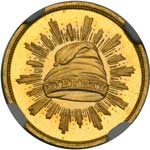 |
1836 Pattern Gold Dollar. Gold, plain edge. Judd-67. Pollock-70. Rarity 5. NGC graded Proof 64+ Cameo. CAC Approved. PQ. A brilliant gem. Only 5 struck. A simple but beautiful design on a coin that is the historic predecessor of the 1849-1889 series of Gold Dollars. The obverse depicts a Liberty cap. Around it, a "glory" sunrays, which has a likeness to contemporary Mexican gold pieces of this decade. The reverse has the denomination "1 D." within a palm frond; date is below and UNITED STATES OF AMERICA arching above. Christian Gobrecht, the mint�s talented engraver, is behind this attractive design. Struck in gold alloy with a plain edge, Judd-67 Pattern has significant historical ramifications, being the proto-Federal gold dollar Pattern as well as the first Pattern to be struck in gold. This bright golden specimen display cameo contrast over near-gem quality mirror fields; furthermore, we report a needle-sharp strike and reflective, smooth fields, while the reverse, in keeping with the overall excellence, displays bold a device as well. Pop 1; 4 finer, 3 in 65, 1 in 66.
Historic Note for 1836: This year is notable for the appearance of Patterns for two denominations which were not regularly issued until many years later, the two-cent piece and the gold dollar.
Engraver Christian Gobrecht interrupted his work on the second obverse of the silver dollar named after him to make the simple dies for the Pattern gold dollar. The dies were completed and specimens struck before March 14, 1836, for a letter of that date from the Director to the Secretary of the Treasury enclosed a specimen in gold.
This year also marks the beginning of coinage with the steam press.
Estimated Value $19,000 - 21,000.
View details and enlarged photos
| Realized
$27,025 |
Lot 1649 |
 |
1855 Pattern Cent. Bronze, plain edge. Original. Judd-168. Pollock-193. NGC graded Proof 65 Brown. A popular Pattern issue. Even brown toning. Razor-sharp and gem quality surface from center to periphery. Only two or three of the stars lack compete radial lines. Large flying eagle design by Mint Engraver James B. Longacres, whose modified eagle would grace the 72-grain weight Flying Eagle cents of 1856-58. This is an early proposal, with stars around the eagle, the date below. Longacre's signature slanting 5s are seen in the date, an attractive artistic touch. Pop 1; 2 finer in 66. (PCGS # 11720) .
Estimated Value $1,900 - 2,000.
View details and enlarged photos
Check results on similar lots
| Realized
$2,938 |
Lot 1650 |
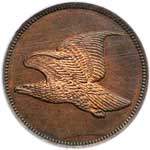 |
1856 Pattern Cent. Copper, plain edge. Judd-179. Pollock-207. NGC graded Proof 65 Red & Brown. Nice old time toning and Gem quality surfaces, with bold, razor-sharp detail. Gorgeous pinkish-red and lilac-toned surfaces on both sides are pristine and distraction-free. An arcing small mark is noted in the area where the date would normally appear. A similar curving mark appears on the reverse near the rim at 12 o'clock, running through the right wreath tip -- definite pedigree markers for this remarkable and rare coin.
The design pairs the regular Flying Eagle cent motif of 1856-58 on the obverse with the first of Longacre�s two Agricultural Wreath reverses. Intriguingly, there is no date, nor are there other legends, save for the denomination ONE CENT in the center reverse. Struck in copper with a plain edge.
Pollock observes that the eagle is a "direct copy of the eagle featured on the Gobrecht dollars dated 1836 to 1839." This pattern could just as easily be called a "Gobrecht cent," crediting the obverse's original designer, Christian Gobrecht, rather than merely describing the design. Examples were struck in both copper and copper-nickel, with the latter somewhat rarer -- but both are rare. The dated Judd-180 is the R.1 1856 Flying Eagle Cent pattern, a high-mintage production (for a Pattern, at least) that is collected alongside the regular-issue series. Uspatterns.com reports more than a dozen are known of this copper undated variety.
Pop 1; none finer at NGC. The only Proof Red & Brown example graded by NGC for the variety.
Information from the Judd reference: "During this year Congress was considering the bill which became the Act of February 21, 1857. This authorized cents weighing 72 grains to be struck from an alloy of 88% copper and 12% nickel. These were intended for the redemption of the large cents and the fractional parts of the Spanish and Mexican dollars, which had been passing freely throughout the country for a long time.
"During this period the Melter and Refiner, Booth, had continued the experiments, trying to find a better alloy for the cent, under instructions from the Director of the Mint, J. R. Snowden. On July 11, 1856, Mr. Snowden reported to the Secretary of the Treasury, James Guthrie, that recent experiments had shown an alloy of 88% copper and 12% nickel to be far superior to bronze. 'I have accordingly caused some specimens to be struck, fifty pieces of which I send you by Mr. Colmisnil, an agent of the Department. To prevent expense & delay we have used the half-cent dies. The specimens will show that the mixture receives a good impression from the dies, and exhibits its color and general appearance.' Mr. Snowden then proposed that cents be authorized in this alloy with a standard weight of 72 grains, maximum deviation 3 grains."
…
"After the dies for the flying eagle cent were prepared Mr. Snowden wrote to Mr. Guthrie on Dec. 4, 1856 as follows: 'Sir, I have caused a few hundred specimens of the proposed new cent to be struck. It would probably aid us in our efforts to deliver the Country from the present large and unsightly coin if a specimen were furnished to each member of Congress. If you concur in this suggestion I will deliver the department from the trouble of distributing them and send them to the Members of Congress, or transmit them to you for distribution if you prefer that course.'"
"According to other letters in the Archives two specimens had been sent to Mr. Guthrie, four to President Pierce, and 200 to Representative S. D. Campbell on Feb. 2, 1857, and Mr. Snowden enclosed 100 more specimens in a letter to Mr. Guthrie on Feb. 4, 1857.
"It is presumed that every Congressman, Senator, and member of the Treasury Department got one or more specimens.".
Estimated Value $28,000 - 30,000.
Ex Lemus Collection.
View details and enlarged photos
| Unsold |
Lot 1651 |
 |
1859 Pattern Cent. Copper-Nickel, Plain Edge. Judd-228. Pollock-272 Rarity 1. NGC graded MS-65. Considerable mint luster visible. A boldly made Gem. Collectors are drawn instinctively to Judd-228 because of its transitional nature. As with many new Mint designs, the engraving department must design a coin that meets several often contradictory needs. One is to produce a well-balanced design; another is to have the design laid out on the dies so as to minimize striking problems. It must have been that Longacre's regular-issue 1859 Indian cent with laurel wreath reverse did not meet one of these criteria. He altered the reverse, therefore, to the more familiar oak wreath, and added a shield at the top. Judd-228 is the bridge between his regular 1859 and the modified 1860 piece. Pop 42; 9 finer, 1 in 65+, 8 in 66 (PCGS # 11932) .
Estimated Value $1,200 - 1,300.
View details and enlarged photos
Check results on similar lots
| Unsold |
Lot 1652 |
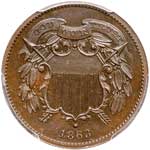 |
1863 Pattern Two Cents. Bronze, plain edge. Judd-312. Pollock-377. PCGS graded Proof 65 Brown. CAC Approved. Lovely blue and brown toning. Pop 13; 3 finer in 66. This Pattern carries the earliest version of a national Motto, GOD OUR TRUST. It would thereafter be replaced by the more familiar IN GOD WE TRUST
At the time the Mint was examiining a replacement for the problematic copper-nickel cent (1856-64), it also toyed with the idea of a Two-cent denomination in light of the critical shortage of small change during the Civil War. Mint Director Pollock wrote to the Secretary of the Treasury (Chase):
"I also propose for your consideration the coinage of a two-cent piece, same material and double weight of the cent, and with such devices and motto as may be approved by you. This piece would be a great public convenience, and its coinage, in my opinion, should be authorized. The devices are beautiful and appropriate, and the motto on each such, as all who fear God and love their country, will approve. I prefer the "shield and arrows" to the "head of Washington," on the obverse of the coin. They are submitted for your consideration. If you approve the change of material, and the coinage of the two-cent piece, or either, I will, if you direct it, prepare a supplement to the existing laws, to be by you submitted to Congress for their action (PCGS # 60467) .
Estimated Value $2,800 - 3,000.
View details and enlarged photos
Check results on similar lots
| Realized
$3,878 |
Lot 1653 |
 |
1868 Pattern Five Cents. Nickel, plain edge. Judd-633. Pollock-704. PCGS graded Proof 64. Lightly toned. Design with laurel wreath. In 1868, the Mint prepared two sets of dies for the one, three, and five cent pieces. Both had the head of Liberty on the obverse. On the reverse of one set, the Roman numerals I, III, and V were within a wreath of cotton, corn and tobacco; on the other they were within a laurel wreath. It is reported that at least 100 sets were sent to Congressman Kelley for distribution to members of Congress. Pop 26; 9 finer, 7 in 65, 2 in 66. (PCGS # 60851) .
Estimated Value $1,300 - 1,400.
View details and enlarged photos
Check results on similar lots
| Realized
$1,528 |
Lot 1654 |
 |
1870 Pattern Dime. Silver, Reeded Edge. Judd-837. Pollock-928 Rarity 5. NGC graded Proof 66. Incredible multi-dimensional toning. A bold example of the STANDARD silver proposal for subsidiary coinage. The Mint produced a whole host of beautiful Patterns in 1869-71, but since Congress never picked up the ball and ran with it, the idea of subsidiary silver had to await a later day. Pop 3; 2 finer, 1 in 67, 1 in 67 Star (PCGS # 61081) .
History of the Standard Silver Pattern Coins: The year 1869 marked the advent of a remarkable series of Pattern pieces, known as the Standard Silver series, which were intended to be used to replace the fractional currency. This consisted of denominations of fifty, twenty-five and ten cents which were smaller in size and lighter in weight than the regular United States coins of equal denomination. They were to be struck in the same silver alloy as the authorized United States silver coins, but the weight of the half dollar was to be reduced from 192 to 154 grains, the quarter from 96 to 77 grains and the dime from 38 1/10 to 31 1/2 grains. The intention of the reduced weight was to prevent hoarding and exportation. The value was to depend upon the authority of their Issue rather than upon their bullion value so that they might be current whether gold was at par with paper money or not. William Barber made dies for three different obverses for each denomination after designs by J. B. Longacre. These sets of nine pieces each were struck in silver, copper and aluminum with plain and reeded edges and sold at the mint for fifteen dollars a set. Additional such Pattern coins marked either STANDARD SILVER or just STANDARD were struck in 1870 and 1871.
Estimated Value $2,800 - 3,000.
View details and enlarged photos
Check results on similar lots
| Unsold |
Lot 1655 |
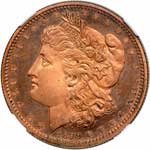 |
1879 Pattern Half Dollar. Copper, Reeded edge. Judd-1600. Pollock-1795. Rarity 7. NGC graded Proof 63 Red Cameo. A fresh, choice red pattern with some spots on both sides. This elegant design are the same as listed for Judd-1599, though instead of silver, Judd-1600 is struck in copper with a reeded edge. This is a sensational red piece with vibrant copper-bright hue throughout and strong cameos. Central weakness is seen on both sides, which we believe is characteristic for the few known specimens. A few tiny carbon flecks, as noted, on the obverse and reverse will further serve as provenance markers. This only Red Cameo specimen is possibly destined for a top-notch US Pattern collection.
The obverse has a portrait of Liberty nearly identical to the one seen on the Morgan dollar, but reduced for the smaller-diameter Half Dollar denomination. The inscription E PLURIBUS UNUM and the accompanied stars differ in placement from the Morgan Dollar. The reverse eagle has its wings partially spread, while holding an olive branch and a trio of arrows in its claws. IN GOD WE TRUST occupies the space below, along with the denomination and UNITED STATES OF AMERICA. Pop 1; none finer at NGC. The only example graded as Proof Red Cameo by NGC.
Estimated Value $5,000 - 6,000.
View details and enlarged photos
| Unsold |
Lot 1656 |
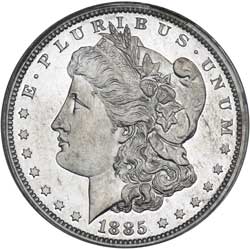 |
1885 Pattern Dollar. Aluminum, lettered edge. Judd-1749. Pollock-1961 Low Rarity 7. PCGS graded Proof 65. Housed in an Old Green Holder. Sometimes called the Snowden Dollar or Snowden Pattern Dollar, the obverse and reverse of this 1885 issue are identical to that of the regular 1885 Morgan Dollar. The edge is, however, lettered ***** E * / PLURIBUS * / UNUM *****. Struck in aluminum. This is neither a major rarity nor is it in the least bit common, as a Low Rarity-7, the is an tremendously popular with collectors of Pattern coins. Even a few Silver Dollar specialists who have heard about it want one as part of a comprehensive collection. This beautiful Gem has exceptional color with aluminum-white sheen throughout. The surfaces are equally prestigious in quality with the aesthetic appeal, taken as a whole, downright splendid. This is among the finest Snowden dollars in existence. Pop 2; 3 finer in 66
(Aluminum was the new "wonder metal" of the mid-1800s when this piece was made. Light and easy to work, it had splendid properties and possibilities. There was only one drawback: price. Although the price of aluminum fell to below that of silver by the early 1860s, it was still expensive to produce, hovering around twelve dollars a pound between 1862 and 1886. It retained this status until metallurgists found a way to smelt it in quantity. As a consequence, the US. mint struck only limited numbers of aluminum Patterns and die trial pieces each year, often Rarity-6 or Rarity-7 items. (In 1889, man's technology finally caught up with his need for large quantities of this miracle light metal; prices plunged and aluminum was soon being used to make tokens, medals, promotional badges, inflation coins by the jillion, and all sorts of other doodads.) (PCGS # 62191) .
The experimental dollar, with the motto E PLURIBUS UNUM in raised letters on the edge, was suggested by Col. A. Loudon Snowden, Superintendent of the Mint. This represents the first use of the lettered edge since the experiments by Dr. J. T. Barclay in 1857, although J. R. Eckfeldt and J. B. Longacre had recommended its adoption in 1860.
Estimated Value $8,000 - 9,000.
Ex: The Worrell Auction Sept. 1993 Lot 621.
View details and enlarged photos
Check results on similar lots
| Realized
$12,925 |
Lot 1657 |
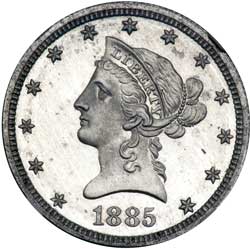 |
1885 Pattern Eagle. Aluminum, reeded edge. Judd-1755. Pollock-1968. Rarity 8. NGC graded Proof 66. A small minor mark in the right obverse field, perhaps as made. Very rare. Pop 1; none finer at NGC.
Struck with regular issue 1885 Proof $10 Gold Eagle dies, but in aluminum with a reeded edge. Examples of aluminum strikings are also known for the other gold denominations of this year, which might have been made for presentation purposes. Pollock lists only three examples of this rare die trial:
1. Ex: 1976 ANA Sale (Stacks, 8/76), lot 3693.
2. Ex: King of Siam Sale (Bowers & Merena, 10/87), lot 2259; Auction '88 (Superior, 10/88), lot 293. This is the present example.
3. Ex: Palace Collection (Sotheby's, 1954), lot 2014.
The coin is lightly toned in irregular streaks of pale tan iridescence that are most readily apparent over the right reverse. The devices are fully brought up in all areas. Identifiable by a fully retained mint-made lamination above star 12 (PCGS # 62198) .
Estimated Value $18,000 - 20,000.
Ex: King of Siam Sale (Bowers & Merena, 10/87), lot 2259; Auction '88 (Superior, 10/88), lot 293; Heritage's January 2004 sale.
View details and enlarged photos
Check results on similar lots
| Realized
$14,688 |
|
|